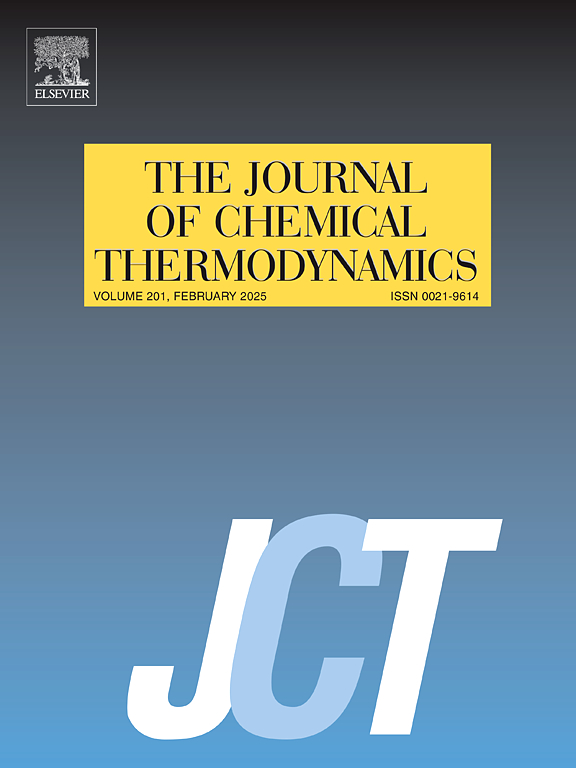Determination of Oxygen Activity Coefficient and Solubility in Lead Nuclear Coolant by Zirconia Solid Electrolyte
IF 2.2
3区 工程技术
Q3 CHEMISTRY, PHYSICAL
引用次数: 0
Abstract
Liquid lead is the chosen coolant for a GEN-IV fast reactor type, the Lead-cooled Fast Reactor (LFR). The content of oxygen dissolved in the coolant is a crucial parameter influencing the oxidation of steels, dissolved corrosion products and lead itself. In this work, we validate Electrochemical Oxygen Sensors (EOSs) and Pumps (EOPs) technology by characterizing the O-Pb-PbO liquid system. Specifically, combing potentiometry by the EOSs with the coulometry by the EOPs along with a customized analytical procedure and numerical analysis, we assessed the oxygen activity coefficient thermal trend, arriving at the following correlation (w.r.t. O2(g) at 1 bar reference standard state for gaseous oxygen, and 1 wt% standard stated for oxygen dissolved in molten lead): (621 K ≤ T ≤ 825 K).
Moreover, measuring the EOS open circuit potential in oxygen-saturated lead at different temperatures we assessed the solubility of oxygen, corresponding to the phase boundary between oxygen-saturated liquid lead and solid lead monoxide (PbO), represented by the following correlation: (618 K ≤ T ≤ 824 K).
The experimental assessments are in good agreement with the most updated results in literature and cover on of the lowest temperatures ever investigated (e.g. 620 K). This work confirms the reliability EOS/EOP technology. Moreover, a detailed and standardized analytical procedure is proposed to conduct thermochemical investigations in Heavy Liquid Metals (HLMs) based on Solid-State Ionics.
氧化锆固体电解质测定铅核冷却剂中的氧活度系数和溶解度
液态铅是GEN-IV型快堆——铅冷快堆(LFR)所选择的冷却剂。冷却液中溶解氧的含量是影响钢的氧化、溶解的腐蚀产物和铅本身的重要参数。在这项工作中,我们通过表征O-Pb-PbO液体系统来验证电化学氧传感器(EOSs)和泵(EOPs)技术。具体来说,结合EOPs电位法和EOPs库伦法以及定制的分析程序和数值分析,我们评估了氧活度系数的热趋势,得出以下相关性(气态氧在1 bar参考标准状态下的w.r.t O2(g),以及溶解在熔融铅中的氧规定的1 wt%标准):log10γOPb∞wt.%−1单位=2.22−6517.74±0.04TK (621 K≤T≤825 K)。此外,通过测量氧饱和铅在不同温度下的EOS开路电位,我们评估了氧的溶解度,对应于氧饱和液体铅和固体一氧化铅(PbO)之间的相界,由以下相关性表示:log10SOPbwt.%=2.95−4909.94TK (618 K≤T≤824 K)。实验评估与文献中最新的结果很好地一致,并涵盖了迄今为止研究的最低温度(例如620 K)。这项工作证实了EOS/EOP技术的可靠性。此外,本文还提出了一种详细的、标准化的基于固态离子的重金属热化学分析方法。
本文章由计算机程序翻译,如有差异,请以英文原文为准。
求助全文
约1分钟内获得全文
求助全文
来源期刊

Journal of Chemical Thermodynamics
工程技术-热力学
CiteScore
5.60
自引率
15.40%
发文量
199
审稿时长
79 days
期刊介绍:
The Journal of Chemical Thermodynamics exists primarily for dissemination of significant new knowledge in experimental equilibrium thermodynamics and transport properties of chemical systems. The defining attributes of The Journal are the quality and relevance of the papers published.
The Journal publishes work relating to gases, liquids, solids, polymers, mixtures, solutions and interfaces. Studies on systems with variability, such as biological or bio-based materials, gas hydrates, among others, will also be considered provided these are well characterized and reproducible where possible. Experimental methods should be described in sufficient detail to allow critical assessment of the accuracy claimed.
Authors are encouraged to provide physical or chemical interpretations of the results. Articles can contain modelling sections providing representations of data or molecular insights into the properties or transformations studied. Theoretical papers on chemical thermodynamics using molecular theory or modelling are also considered.
The Journal welcomes review articles in the field of chemical thermodynamics but prospective authors should first consult one of the Editors concerning the suitability of the proposed review.
Contributions of a routine nature or reporting on uncharacterised materials are not accepted.
 求助内容:
求助内容: 应助结果提醒方式:
应助结果提醒方式:


